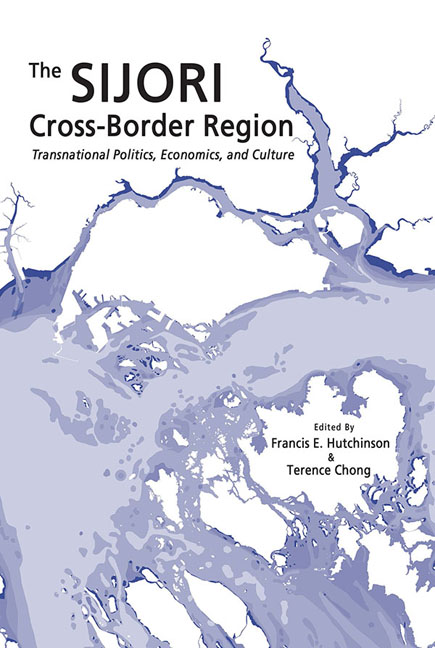Book contents
- Frontmatter
- Contents
- List of Maps
- List of Tables
- List of Figures
- Foreword
- Acknowledgements
- Contributors
- Abbreviations
- Introduction
- Section I Understanding the Whole
- Section II Policy and Politics
- Section III Cross-Border Social and Cultural Communities
- Section IV Formal and Informal Economies
- Map5
- 13 The Airport and the Territory: Transnational Flows in the Singapore- Johor-Riau Cross-Border Region
- 14 Revisiting Industrial Dynamics in the SIJORI Cross-Border Region: The Electronics Industry Twenty Years On
- 15 Development in Johor and Singapore's Water Access: Challenges and Opportunities
- 16 The Role of Ethnic Chinese Business Networks in the Regionalization Strategy of Singaporean Fish Farming Firms
- 17 Pirates and Law Enforcement Agencies: Complex Relations Across the Malacca Straits
- Conclusion
- Appendix
- Sources for the SIJORI Maps
- Index
14 - Revisiting Industrial Dynamics in the SIJORI Cross-Border Region: The Electronics Industry Twenty Years On
from Section IV - Formal and Informal Economies
Published online by Cambridge University Press: 22 July 2017
- Frontmatter
- Contents
- List of Maps
- List of Tables
- List of Figures
- Foreword
- Acknowledgements
- Contributors
- Abbreviations
- Introduction
- Section I Understanding the Whole
- Section II Policy and Politics
- Section III Cross-Border Social and Cultural Communities
- Section IV Formal and Informal Economies
- Map5
- 13 The Airport and the Territory: Transnational Flows in the Singapore- Johor-Riau Cross-Border Region
- 14 Revisiting Industrial Dynamics in the SIJORI Cross-Border Region: The Electronics Industry Twenty Years On
- 15 Development in Johor and Singapore's Water Access: Challenges and Opportunities
- 16 The Role of Ethnic Chinese Business Networks in the Regionalization Strategy of Singaporean Fish Farming Firms
- 17 Pirates and Law Enforcement Agencies: Complex Relations Across the Malacca Straits
- Conclusion
- Appendix
- Sources for the SIJORI Maps
- Index
Summary
INTRODUCTION
Launched in 1989 and originally encompassing Singapore, the Malaysian state of Johor and the Indonesian island of Batam, the SIJORI Growth Triangle sought to market the three territories as a “single investment destination” offering different cost structures yet closely linked by proximity, free trade zones, and a significant degree of political capital (Smith 1996; Sparke et al. 2004). Singapore, possessing significant financial, technological and managerial capital, yet facing rising land and labour costs, was the “core” of the region, while Johor and Batam occupied the land, labour and resource-intensive spaces (Thambipillai 1998).
The economic logic, enabled by investment liberalization — particularly in Batam — and infrastructure investments in both non-core regions led to major flows of investment during the 1990s (Smith 1997; Hutchinson 2012). Of note was the electronics industry which, buoyed by high levels of Japanese investment, expanded significantly during this period.
However, over time, the Growth Triangle lost momentum as the governments of both Malaysia and Indonesia included more and more territories under this initiative, thus diluting its economic rationale (Phelps 2004). In addition, diplomatic relations between all three nations went into flux in the late 1990s, as relations between Singapore and Malaysia cooled and Indonesia, for its part, underwent far-reaching political changes following the end of the New Order (Ooi K.G. 2009; Crouch 2010). Since then, investment authorities in all three territories have continued to promote the advantages of proximity and cost differentials, albeit in a less concerted fashion.
As far as the Electrical and Electronics (E&E) industry is concerned, the territorial division of labour (core-periphery) between SIJORI's component parts established itself during the initial period. This was reconfirmed in research carried out during the 1990s and early 2000s (Grundy-Warr, Peachey and Perry 1999; Lee T.Y. 1991; Ooi G.L. 1995; Smith 1997; Sparke et al. 2004; Toh and Low 1993; Yaw, McGovern and Budhwar 2000; Yeoh et al. 1992, 2004a, 2004b, 2004c; van Grunsven, Wong and Won 1995).
In tandem with the Growth Triangle's visibility, research on the E&E industry connecting the three regions has since dwindled. What research there is, focusses largely on Singapore and its policy frameworks.
- Type
- Chapter
- Information
- The SIJORI Cross-Border RegionTransnational Politics, Economics, and Culture, pp. 370 - 392Publisher: ISEAS–Yusof Ishak InstitutePrint publication year: 2016



